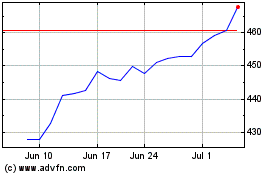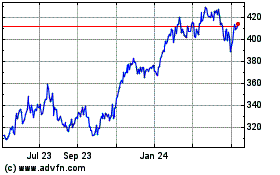Google Inc (GOOG) started the year in style,
beating our earnings estimate of $8.24 by 51 cents, or 6.2%.
Revenue was more or less in line with consensus estimates of $8.1
billion.
Historically, Google has done much better than Yahoo
Inc (YHOO), which has been struggling to hold its own, and
Microsoft Corp (MSFT), which is yet to gain
critical mass. Google’s superior algorithms have consistently
attracted more users and generated better conversions.
Revenue
Google’s gross revenue touched a record $10.65 billion,
representing sequential and year-over-year increases of 0.6% and
24.1%, respectively. Considering Google’s hedging program, the
impact of currency was minimal on both sequential and
year-over-year bases.
Google is very strongly positioned in the mobile platform, where
both smartphones and tablets have been making strong headway. The
dominant position has enabled Google to generate very strong mobile
revenue growth. In fact, the company’s position in mobile looks
better than it was in traditional computing, which says something
about its strategic planning and execution.
Additionally, Google continues to benefit from the secular shift
in advertising spending from offline to online properties,
increasing contribution from medium and small-sized advertisers,
success of the DoubleClick ad exchange, improving search algorithms
and better ad quality.
Revenues from both Google-owned and partner sites continued to
grow double-digits on a year-over-year basis (they have grown
double-digits each quarter over the last few years). Google
websites accounted for around 69% of quarterly advertising revenue,
while partner sites accounted for another 27%.
Total advertising revenue was flat sequentially and up 23.0%
year over year. Google-owned sites were stronger than partner sites
on a year-over-year basis.
Total traffic acquisition cost (the portion of revenue shared
with Google’s partners) was down 16.0% sequentially, although it
continued to increase (up 24.5% from last year). However, we do not
consider this a reason for concern since the traffic acquisition
cost as a percentage of total advertising revenue dropped 481 basis
points (bps) sequentially and was flattish when with the year-ago
quarter. Net advertising revenue, excluding traffic acquisition
cost was up 7.3% sequentially and 23.0% year over year.
Licensing and other fees brought in the remaining 4% of revenue
in the last quarter, up 3.7% sequentially and 58.0% from the March
2011 quarter.
Total revenue excluding total traffic acquisition costs came in
at $8.14 billion, just short of the Consensus Estimate of $8.15
billion.
The U.S. generated around 46% of revenue, down 11.7%
sequentially and up 21.7% from a year ago. The U.K., with an 11%
revenue share was up 8.5% sequentially and 18.7% from last year.
Other markets accounted for the remaining 43% of revenue,
representing sequential and year-over-year increases of 15.5% and
28.3%, respectively.
Google stated that Western European countries, such as the U.K.,
France and Germany grew strongly, with Italy remaining slightly
sluggish. Additionally, growth accelerated across Asia, with Japan
coming in particularly strong as it benefited from increasing
contribution from the SMB segment.
Margins
The gross margin of 64.4% was down 62 bps sequentially and 136
bps from the year-ago quarter. The gross margin performance was the
combined effect of revenue growth, a 7% sequential (39%
year-over-year) increase in the number of paid clicks, and a 6%
sequential decline (also 12% year-over-year decline) in the cost
per click.
The number of paid clicks and cost per click appears
significant, as they are indicative of higher volumes coming at
lower prices. The mobile and emerging markets businesses are
growing strongly, which could be the reason.
Other costs, associated with data center operation, amortization
of intangible assets, content acquisition and credit card
processing increased from the year-ago quarter, increasing the
pressure on the gross margin.
Operating expenses of $3.47 billion were higher than the
previous quarter’s $3.37 billion. The operating margin was 31.8%,
down 130 bps from the 33.1% recorded in the previous quarter and
down 77 bps from last year. R&D as a percentage of sales
declined significantly from the year-ago quarter, although it was
up on a sequential basis.
S&M expenses declined slightly as a percentage of sales from
both the previous and year-ago quarters. Google’s recent hiring
actions have been mainly focused on these two areas and it looks as
if it is nearly done with its hiring activities. Other than fresh
recruits, the company typically adds quite a few through
acquisitions.
Non-operating gains were $156 million, up from a loss of $18
million in the previous quarter and income of $96 million in the
March 2011 quarter. Google had some investment gains in the last
quarter, which more than offset the impact of lower interest
income.
Google reported net income of $2.89 billion, or 27.1% of sales,
compared to $2.71 billion, or 25.6% of sales in the December 2011
quarter and $2.30 billion, or 26.8% of sales in the year-ago
quarter. GAAP earnings of $8.75 a share were down from $8.22 in the
previous quarter and $8.57 in the March quarter of 2011. There were
no special items in the last quarter.
Balance Sheet
Google has a solid balance sheet, with cash and short term
investments of nearly $49.3 billion, up $4.7 billion during the
quarter. The company generated around $3.69 billion from operations
in the last quarter and spent $607 million on capex, netting a free
cash flow of $3.09 billion.
Our Take
Google reported another strong quarter, with the double-digit
revenue growth driving double-digit growth in earnings. Higher
non-operating income and a lower tax rate were other positives for
the quarter. Management’s hiring activities appear to be tapering
off, which should be a positive for earnings in the next few
quarters.
The company generates revenue primarily from the sale of
advertising space on its online properties. It has therefore
focused on protecting and growing its position in the search market
through continued innovation and quality improvements.
This focus has ensured that it remains the dominant player in
search, not just in the traditional computing segment, but even
more so in the emerging mobile space. Google’s Android OS has come
a long way to cementing its position in mobile. Google has also
made acquisitions over time that have augmented its in-house
capabilities.
With the growing importance of social networking, Google
introduced Google+. While some have commented that Google will not
be as popular as Facebook, this is really not that much of a
concern and remains to be seen. In the meantime, it is obvious that
social data will be an additional tool for Google, which has been
making a number of acquisitions and innovations in the space.
Management has stated that social relevance in search is resulting
in better conversions.
Toward the end of last year, Google stepped up efforts targeting
the small and medium business (SMB) segment. The SMB segment has
played a key role in elevating Google’s position in display and we
expect the company to continue chipping away at Yahoo’s market
share. Google’s success in display is very encouraging, since
display advertising is expected to grow very strongly over the next
few years, surpassing search advertising by 2015.
Despite the initiatives to drive growth and superb execution to
date that have enabled the company to maintain share in a
fast-growing market, Google’s share prices have been more or less
range-bound over the last six months or so. This could be because
of its many legal entanglements related to competitive matters or
patent infringements, such as Oracle Corp’s (ORCL)
lawsuit against it.
Google shares carry a Zacks Rank of #3, implying a short-term
Hold recommendation.
GOOGLE INC-CL A (GOOG): Free Stock Analysis Report
MICROSOFT CORP (MSFT): Free Stock Analysis Report
ORACLE CORP (ORCL): Free Stock Analysis Report
YAHOO! INC (YHOO): Free Stock Analysis Report
To read this article on Zacks.com click here.
Zacks Investment Research
Microsoft (NASDAQ:MSFT)
Historical Stock Chart
From Mar 2024 to Apr 2024

Microsoft (NASDAQ:MSFT)
Historical Stock Chart
From Apr 2023 to Apr 2024
